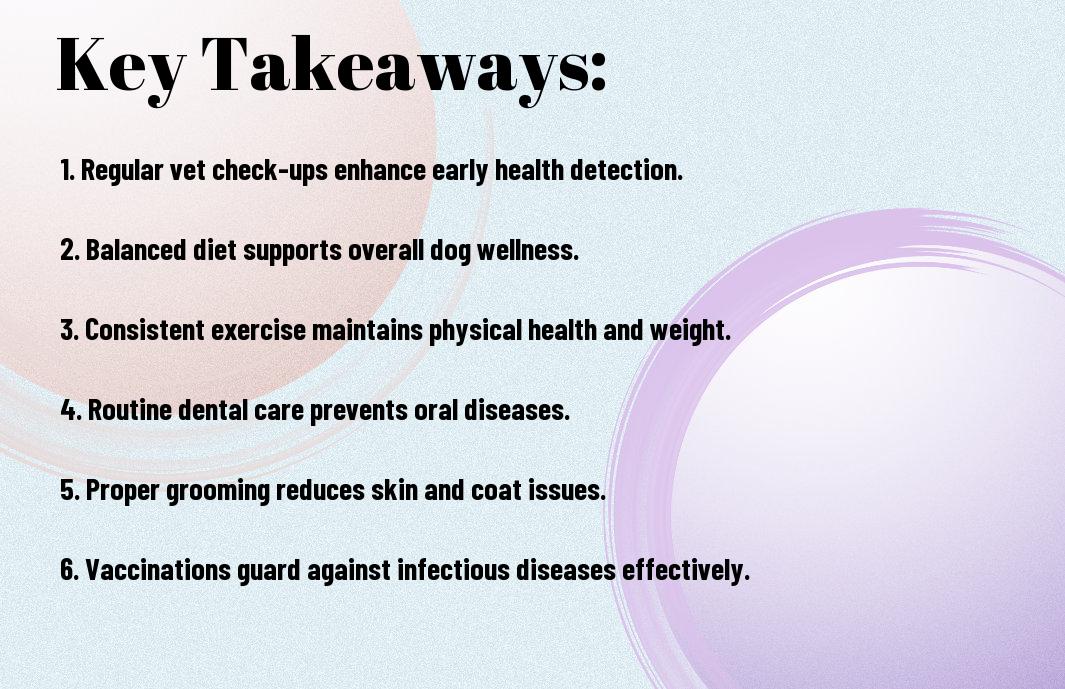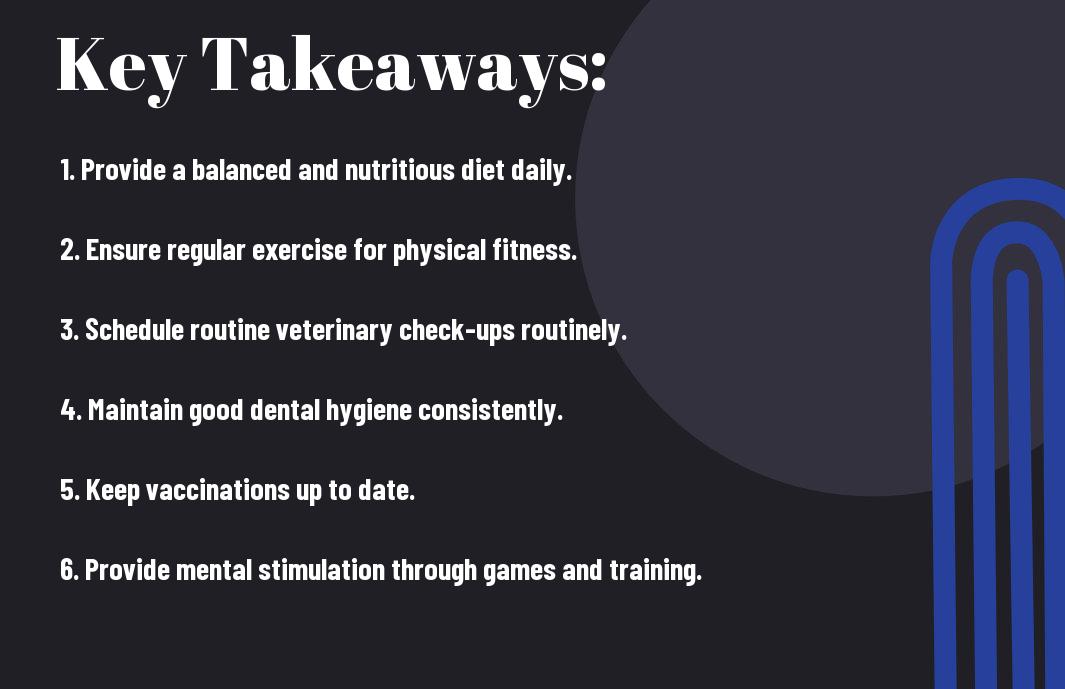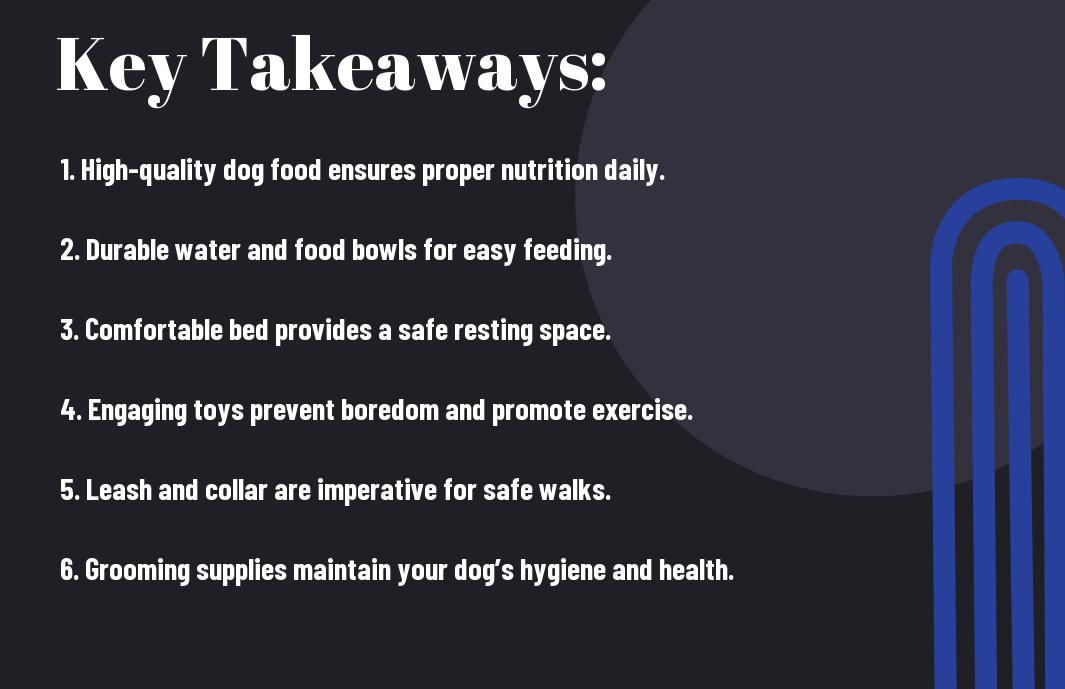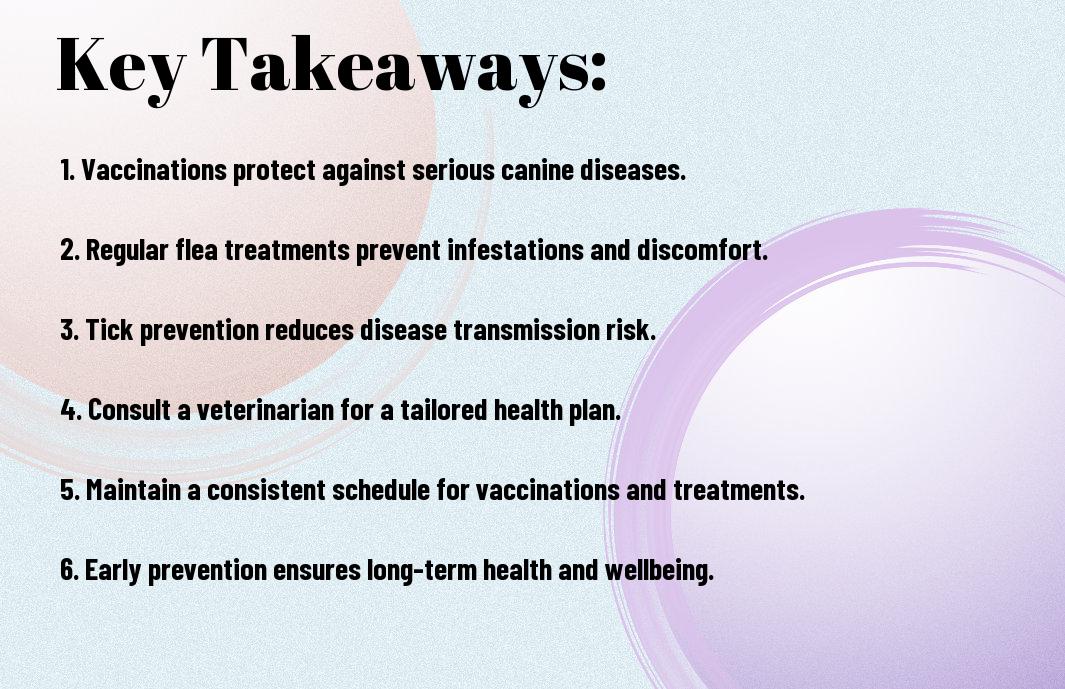Over time, you may notice that your beloved dog faces several health challenges that can impact their quality of life. However, by implementing effective strategies, you can significantly reduce the risk of common dog health issues. From maintaining a balanced diet to ensuring regular veterinary check-ups, your proactive approach can make a huge difference in your dog’s overall well-being. This guide will help you understand key preventative measures that can keep your furry friend healthy and happy for years to come.


Understanding Common Dog Health Issues
The health of your dog is a vital aspect that requires your attention and understanding. Just like humans, dogs can suffer from a variety of ailments, some of which can be quite common. Familiarizing yourself with these issues can empower you to take proactive steps towards health maintenance, ensuring that your furry friend leads a happy and active life.
Overview of Common Ailments
Beside the joys they bring into your life, dogs can experience several health issues ranging from minor to serious. Common ailments include skin infections, ear infections, obesity, dental diseases, and gastrointestinal problems. Each of these conditions can arise due to various factors, including genetics, environment, and lifestyle. Understanding these common health challenges is necessary for early prevention.
Additionally, age can play a significant role in the onset of specific health issues. Older dogs may face more age-related problems such as arthritis or organ dysfunctions, while younger dogs might be more prone to infectious diseases. Knowing these trends will help you to tailor your pet care more effectively to maintain their health.
Importance of Preventive Care
Any dog owner should recognize the value of preventive care in maintaining their pet’s health. Regular check-ups with the veterinarian, vaccinations, proper nutrition, and adequate exercise can significantly reduce the risk of many diseases. By taking these proactive steps, you safeguard your dog against common ailments that may otherwise lead to more severe health issues.
A well-structured preventive care plan not only enhances your dog’s quality of life but can also save you from costly veterinary bills down the road. Being vigilant and taking care of your dog’s health helps to create a bond of trust, ensuring they remain energetic and healthy companions for years to come.
Recognizing Symptoms Early
Ailments can often go unnoticed until they develop into more significant issues, which is why early recognition of symptoms is necessary. Signs such as excessive scratching, lethargy, vomiting, or changes in appetite should prompt you to consult your vet. Being aware of your dog’s typical behavior will help you spot any irregularities that may indicate underlying health issues.
Additionally, regular observation of your dog’s behavior and habits can aid in early detection. Changes such as reluctance to play, weight gain, or sudden aggression can be red flags signaling health concerns. The sooner you act upon these concerns, the more likely you are to address potential problems before they escalate.
In fact, some symptoms can be subtle or easily dismissed, which is why being proactive in monitoring your dog’s health can make all the difference. Developing a keen eye for your pet’s usual state can empower you to take timely action, potentially saving your dog from unnecessary suffering and ensuring they stay well by your side.
Nutrition and Diet Management
The Role of Balanced Nutrition
You understand that a well-balanced diet is key to your dog’s overall health. Against the backdrop of various canine health issues, nutrition serves as the foundation upon which everything else is built. A balanced diet not only provides vital nutrients but also aids in the prevention of obesity, diabetes, and digestive problems. Selecting high-quality dog food tailored to your pet’s specific needs—whether they are puppy, adult, or senior—is vital in promoting long-term health and wellness.
You should also know that maintaining a proper balance of proteins, fats, vitamins, and minerals can significantly elevate your dog’s quality of life. Against the continual threat of chronic diseases, feeding your canine friend appropriate portions of food while avoiding excessive calorie intake can reduce the risk of weight-related health issues that plague many pets today.
Identifying Food Allergies
Among the various health concerns that can affect your dog, food allergies are often overlooked but can be a significant contributor to skin irritations, vomiting, and gastrointestinal problems. Knowing the signs of food allergies, such as constant itching, paw licking, or unusual bowel movements can help you take action before conditions worsen. If you suspect that your dog may be suffering from a food allergy, a consultation with your veterinarian is advisable for a proper diagnosis and potential dietary adjustment.
Identifying food allergies can often require a process of elimination, where new food options are gradually introduced while you monitor for reactions. This can help pinpoint the specific ingredient causing the issue. Some common allergens in dog food include beef, dairy, chicken, wheat, and soy—so staying informed about your dog’s dietary intake is vital in managing their health effectively.
Supplementing for Health
Below the surface of a well-balanced diet lies the potential need for supplements, which can provide additional health benefits that might not be fully addressed through food alone. As you consider adding supplements to your dog’s routine, exploring options like omega fatty acids, probiotics, and joint support formulas can be beneficial. These supplements can enhance your dog’s immune function, improve skin and coat health, and promote healthy joint mobility, effectively tackling specific health concerns before they develop into more significant issues.
Due to the diverse needs of dogs, it’s vital to consult with your veterinarian prior to injecting any supplements into your dog’s diet. They can help assess your dog’s specific requirements based on age, breed, and health status, guiding you to the best choices for supplementation that align with a holistic approach to your pet’s nutrition and overall well-being.
Regular Veterinary Care
After bringing your new furry friend home, establishing a routine of regular veterinary care is important for ensuring their long-term health and happiness. Regular check-ups allow your veterinarian to monitor your dog’s overall well-being and identify any potential health issues before they become serious. By prioritizing these visits, you can take a proactive approach to your dog’s health, giving you peace of mind and a happier, longer life for your pet.
Importance of Routine Check-ups
For every dog owner, understanding the importance of routine veterinary check-ups is fundamental. These appointments provide an opportunity for your veterinarian to conduct a thorough physical examination, assess crucial indicators like weight, coat condition, and dental health, and screen for common health problems. Early detection and intervention can significantly impact your dog’s quality of life, helping to manage health issues more effectively. Furthermore, these visits help you establish a trusting relationship with your veterinarian, allowing for a better understanding of your pet’s unique needs.
For example, by regularly bringing your dog for check-ups, your vet can track changes in your dog’s health over time. These ongoing assessments also enable you to discuss any behavioral changes, diet concerns, or lifestyle adjustments that might be necessary as your dog ages. Ultimately, prioritizing routine visits supports not just the physical health of your pet but also fosters a deeper bond between you and your furry friend.
Vaccination Schedules
Before getting your dog’s vaccinations, it’s important to understand that vaccines are important to protecting your pet from various infectious diseases. Your veterinarian will recommend specific vaccines based on your dog’s age, health status, and lifestyle. Staying on schedule with vaccinations helps prevent potentially serious illnesses and minimizes the risk of outbreaks that can affect the broader community of pets.
Considering your dog’s vaccination schedule, it’s vital to keep track of due dates and ensure timely administration. Vaccines not only protect your dog but also contribute to herd immunity in the pet population, preventing the spread of preventable diseases. Your veterinarian will provide you with a vaccination booklet or online record to help you monitor your dog’s vaccination history and upcoming due dates, making it easier for you to stay organized.
Dental Health Considerations
Routine veterinary care should also encompass your dog’s dental health. Regular dental cleanings and examinations are important for preventing periodontal disease and other dental issues that can lead to pain and systemic health problems. Many pet owners overlook dental care, but it’s just as important as vaccinations and check-ups in maintaining your dog’s overall health.
Plus, you can take proactive steps at home to ensure your dog’s teeth and gums stay healthy between vet visits. Regular brushing, providing dental chews, and offering toys designed for dental care can help in maintaining your dog’s oral hygiene. By being proactive about your dog’s dental health, you reduce the risk of costly treatments in the future and improve their overall quality of life.

Exercise and Physical Activity
Keep your dog’s physical health in check by ensuring they receive regular exercise. Just like humans, dogs need physical activity to maintain their overall health, prevent obesity, and improve their mental well-being. Incorporating exercise into your dog’s daily routine can also help ward off various health issues, such as diabetes, cardiovascular disease, and joint problems. Making physical activity a priority in your dog’s life not only enhances their quality of life but also fosters a stronger bond between you and your furry companion.
Benefits of Regular Exercise
Activity plays a significant role in promoting your dog’s physical and mental health. Regular exercise helps to keep their weight in check, strengthens their muscles and bones, and boosts their cardiovascular fitness. An active lifestyle can lead to a longer, healthier life for your dog, significantly decreasing the risk of age-related problems and chronic conditions. Additionally, the mental stimulation that comes from exercise helps alleviate behavioral issues, such as anxiety or excess energy, leading to a well-rounded and content pet.
Creating a Suitable Exercise Regimen
On the journey to developing a suitable exercise regimen, consider your dog’s specific needs and preferences. This includes their age, breed, energy level, and any existing health conditions. For example, younger dogs generally have more energy and require more vigorous activities, while older or less active dogs may enjoy leisurely walks or gentle playtime. Incorporate a mix of activities such as walking, running, swimming, or playing fetch to keep things enjoyable and engaging for your pet.
Suitable exercise regimens should also include consistency and variety to maintain your dog’s enthusiasm and energy levels. Aim for at least 30 minutes to two hours of exercise daily, depending on your dog’s needs, broken into manageable sessions. Utilizing local parks, dog-friendly trails, or even safe backyard space can enhance the experience for both you and your dog. Exploring new environments can also stimulate their senses and promote mental wellness.
Tailoring Activities to Breed and Age
With the vast diversity among dog breeds, understanding how to tailor activities to your dog’s breed and age is vital. Certain breeds are bred for specific tasks, such as herding or hunting, which may mean they require more intensive exercise than a more laid-back breed. Additionally, puppies naturally have an abundance of energy, while senior dogs may thrive with gentler outings or shorter play sessions, depending on their health status.
In addition to considering breed characteristics, it’s important to take your dog’s age into account when planning their exercise. For instance, younger dogs may benefit from high-energy activities like running or agility training, while older dogs may prefer leisurely strolls that still allow for exploration. By observing your dog’s behavior and energy levels, you can adapt their routine accordingly, ensuring they receive the right type of exercise that caters both to their unique needs and promotes their overall health.
Parasite Prevention
Not taking proactive measures against parasites can lead to serious health problems for your dog. Understanding the types of parasites and how they affect your pet is a key step in keeping your furry friend healthy. Regular prevention measures can help eliminate these risks and ensure your dog enjoys a long, happy life.
Understanding Common Parasites
An educated dog owner should be aware of the most common parasites that can affect their pets. Fleas, ticks, and heartworms are among the most notorious culprits. Fleas can cause skin irritations and transmit tapeworms, while ticks can carry Lyme disease and other bacterial infections. Heartworms, on the other hand, are transmitted by mosquitoes and can lead to severe cardiovascular problems if left untreated.
Recognizing the signs of these parasites is equally important. You might notice your dog scratching excessively or showing signs of discomfort. Regular check-ups with your vet can help to identify and treat any infestations early on, making it imperative for dog owners to stay vigilant about their pet’s health.
Effective Flea and Tick Control
By implementing a regular flea and tick prevention plan, you can create a barrier between your dog and these harmful pests. FDA-approved flea and tick medications are available in various forms, including topical treatments, oral medications, and collars. Be sure to consult your veterinarian to determine which option is best suited for your dog’s lifestyle and needs.
Consequently, you should administer these preventive measures consistently, as many flea and tick treatments require ongoing application to remain effective. In addition to medications, consider maintaining a clean living environment by regularly vacuuming and washing your dog’s bedding. Natural repellents, such as imperative oils, can also be used, but always check with your vet before trying alternative solutions.
Heartworm Prevention Strategies
Against heartworm, preventive measures are indispensable. Regular heartworm testing and preventative medication can save your dog’s life, as treatment for heartworm disease is both risky and expensive. Vets typically recommend a monthly oral or topical preventative medication, which is imperative during mosquito season, when the risk of transmission is highest.
Another significant aspect of heartworm prevention is regular vet check-ups. These check-ups should include heartworm tests and discussions about your current prevention strategy to ensure its effectiveness. Staying informed about your area’s prevalence of heartworm can further guide you in making appropriate decisions for your dog’s health and well-being.
Mental Health and Socialization
For your dog to thrive, it is imperative to prioritize their mental health alongside their physical well-being. A mentally stimulated dog is happier, less anxious, and less prone to developing behavioral problems. Engaging your dog in various activities helps to keep their mind sharp and enriches their daily experience, ensuring they remain content and satisfied. Whether through interactive toys, training sessions, or regular playtime, incorporating mental challenges into your dog’s routine can make a significant difference in their overall health.
Importance of Mental Stimulation
Behind every dog’s playful bark and wagging tail lies the need for mental stimulation. When your dog is mentally engaged, they are less likely to develop issues like separation anxiety, excessive barking, or destructive behavior. Activities such as puzzle toys, obedience training, or even simple tasks like hiding treats around your home can activate their problem-solving skills. Not only does this foster a bond between you and your canine companion, but it also cultivates an environment where they can explore their natural instincts and intelligence.
Socialization Techniques
Any dog can benefit from proper socialization, which helps them develop confidence and adaptability in various situations. Introducing your dog to different environments, people, and other animals enhances their social skills and reduces the likelihood of fear-based reactions. Start with controlled environments, like dog parks or puppy classes, where they can gradually learn how to interact appropriately without feeling overwhelmed. Exposure to various experiences, such as car rides, visits to pet-friendly places, or even playdates with other dogs, will greatly assist in their adjustment.
Further adding to your socialization toolkit, you can utilize positive reinforcement techniques. When your dog behaves appropriately in a social setting, reward them with treats or praise, reinforcing their positive behavior. Gradually expose your dog to more challenging scenarios, gradually building their confidence and comfort level. This steady ascent in exposure is key to creating a well-adjusted companion that is less fearful and more social.
Dealing with Behavioral Issues
Across various breeds, behavioral issues can arise for numerous reasons, from lack of socialization to environmental factors. It’s imperative to identify the root causes of these tendencies early on to implement effective strategies that will curb undesirable behaviors. Regular training and consistency in your approach will help create a structured environment for your dog, allowing them to feel secure and understand what is expected of them. Techniques such as distraction, redirection, and positively reinforcing good behavior are practical tools in addressing any concerns that may surface.
Mental stimulation plays an integral role in addressing behavioral issues effectively. When your dog is mentally engaged, they are less likely to succumb to boredom or anxiety-driven behaviors such as chewing or barking excessively. Activities that promote problem-solving and focus can help alleviate stress and provide a healthy outlet for their energy. Ensuring your dog is well-exercised physically and mentally can lead to a more balanced and well-behaved pet.
Home Environment and Safety
Now that you have decided to provide a loving home for your furry friend, it is vital to consider how your living space can promote their well-being. A safe and comfortable environment not only ensures your dog’s happiness but also minimizes the risk of common health problems associated with an unsafe home setting. From choosing the right furniture to selecting safe materials, every aspect of your home can significantly impact your dog’s health.
Creating a Dog-Friendly Space
Beside ensuring a comfortable bed and adequate space for your dog to roam, creating a dog-friendly space involves taking into account their natural behaviors. Consider spaces where they can enjoy playtime, like a designated area for toys that encourages both mental and physical stimulation. Placing non-toxic plants around your home can also add a touch of greenery while keeping your dog safe. Make sure the area is free of sharp objects and easily accessible for your dog to find their food and water bowls.
Additionally, you might also want to think about the layout of your home. Keeping items that could pose a choking hazard—like small household objects—out of reach is always a good idea. Moreover, training your dog to stay off furniture or preventing access to certain rooms can further enhance their safety and comfort. Tailoring your space to accommodate your dog’s needs will help minimize any stress for them and encourage a happier home environment.
Identifying and Reducing Hazards
Space is a critical element when it comes to your dog’s safety at home. Identifying potential hazards involves a meticulous examination of your living space for dangers that could result in accidents or health issues. Look for exposed electrical cords, chemicals stored in accessible cupboards, or unstable furniture that could tip over. By ensuring that your home is free of such risks, you are creating a safer environment for your dog.
With that in mind, you should also consider implementing safety measures such as using baby gates to restrict access to hazardous areas, like stairs or rooms with valuable or dangerous items. Regularly walking through your home and reassessing the environment can help you identify new hazards as your dog grows and explores. This proactive approach in creating a safe space will not only protect your dog from harm but can also prevent stress arising from potentially dangerous situations.
Emergency Preparedness for Pet Owners
By preparing effectively for emergencies, you can ensure your dog’s safety during unexpected situations, such as fires, natural disasters, or medical emergencies. Start by creating a pet emergency kit that includes crucials like food, water, a first-aid kit, and any medications your dog may need. Additionally, make sure you have a safe place for your dog to go during a crisis, and practice evacuating with them, ensuring they remain calm and comfortable during stressful circumstances.
Moreover, staying informed about the various types of local emergencies and associated risks can make a significant difference in your preparedness. Understanding your dog’s behavior during stressful times will help you in creating a tailored approach to emergencies. Keeping contact information for your veterinarian and nearby animal hospitals readily available can also be immensely beneficial, helping you react quickly and efficiently if an emergency arises.
Safety is paramount when it comes to the well-being of your dog. By understanding potential hazards and preparing for emergencies, you can create a secure environment for your furry companion and enjoy many happy years together.
Summing Up
Now that you’ve explored effective strategies for preventing common dog health issues, you can take proactive steps to ensure your furry friend’s well-being. By prioritizing regular veterinary check-ups, maintaining a balanced diet, and ensuring consistent exercise, you position yourself and your dog for a healthier life together. Additionally, being aware of breed-specific health risks and investing time in training will further strengthen your bond while keeping potential health problems at bay.
Using these strategies equips you with the knowledge to provide the best care possible for your dog. It’s crucial to stay informed about advancements in canine health and nutrition, as well as to be vigilant about any changes in your dog’s behavior or physical condition. By taking these steps, you can enjoy many happy years with your pet, free from common health concerns and ready to create lasting memories together.
Q: What are the common health issues faced by dogs, and how can they be prevented?
A: Common health issues in dogs include obesity, dental disease, and parasites. To prevent obesity, ensure your dog maintains a balanced diet and receives regular exercise. Dental disease can be prevented by establishing a dental care routine that includes regular brushing and routine vet check-ups. To guard against parasites, use preventive medications as recommended by your veterinarian and keep your dog’s living environment clean.
Q: How important is regular veterinary check-ups in preventing health issues in dogs?
A: Regular veterinary check-ups play a significant role in preventing health issues in dogs. These visits allow for routine vaccinations, early detection of potential problems, and guidance on nutrition and exercise. A veterinary professional can provide tailored advice specific to your dog’s breed, age, and lifestyle, which helps in maintaining optimal health.
Q: What dietary considerations should be taken into account to promote my dog’s health?
A: A well-balanced diet is fundamental in promoting your dog’s health. Consider providing high-quality pet food that meets their specific dietary needs based on age, size, and activity level. Avoid human foods that can be toxic to dogs, such as chocolate and grapes. Consulting with a veterinarian can help you determine the best diet options and portion sizes suited for your dog’s individual health requirements.










